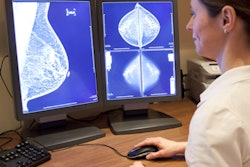
A computer-aided detection (CAD) algorithm based on artificial intelligence (AI) proved to be better than traditional CAD in helping radiologists detect breast cancer. The AI-based CAD could also improve efficiency and increase revenues, according to research presented at ECR 2019 in Vienna.
In a retrospective study involving 250 mammograms that had previously been read with traditional CAD software, Dr. Alyssa Watanabe of the University of Southern California and colleagues from the University of Texas MD Anderson Cancer Center in Houston found that AI-based CAD software yielded over 70% fewer false-positive marks per image, as well as many more normal cases without any marks.
As a result, the AI CAD software could reduce reading time by 64% and enable radiologists to interpret up to 10% more screening exams per year, according to the researchers.
"That could translate -- in a place like MD Anderson that does 100,000 mammograms per year -- to over $1 million in increased revenues," said presenter Watanabe, who is also chief medical officer at AI software firm CureMetrix, the developer of the cmAssist AI-based CAD software used in the study.
The researchers performed a head-to-head comparison of cmAssist with traditional CAD software -- ImageChecker (Hologic) -- on 250 2D mammograms from January to March 2013 consisting of BI-RADS 1, 2, and 0 cases. They calculated the number of marks per image for each CAD method, as well as the number of cases that were recalled.
Both systems identified all three cancers in the study. However, the AI-based CAD software had fewer false-positive marks and significantly more cases that didn't produce any marks.
| Performance of AI vs. traditional CAD software | ||
| Traditional CAD software | AI-based CAD software | |
| Sensitivity | 90% | 98% |
| False positives per image | 0.63 | 0.14 |
| BI-RADS 0 cases without any CAD marks | 17% | 48% |
The AI-based CAD had 77% fewer false positives per image, including an 83% reduction for calcifications and a 56% reduction for masses, according to the researchers.
Watanabe noted that radiologists can be influenced by CAD marks. Of the 18 false-positive cases initially recalled by radiologists from using the traditional CAD software, 15 had marks on traditional CAD software, but only eight had marks on the AI CAD software.
"So, therefore, using the AI-based CAD could translate into fewer recalls, improved workflow, and decreased costs," she said.
Studies in the literature have shown that mammography CAD software can increase reading time for radiologists by an average of 22% and that CAD marks added an additional 23 seconds of reading time. Extrapolating those results with their own data, the researchers found that based on an assumption of 100,000 mammograms, AI would save 375 hours -- or 64% -- of radiologist reading time per year based on fewer marked cases from AI CAD.
Radiologists could then use this time to read up to 10% more screening mammograms per year, increasing revenue by nearly $1.5 million per year based on the Medicare fee schedule, according to Watanabe.



















